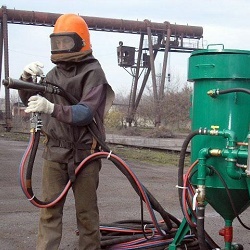Choosing oil and gasoline for a lawnmower
Lawn mower is a useful technique for mowing grass when you need constant care for lawns, park plots. With its help, you can give a well-groomed look to the grass cover much faster than using a manual braid. The most common gasoline units. For them to serve for a long time without repair, they need to spend regular maintenance. One of the mandatory periodic procedures is the replacement of oil. Depending on the device of the internal combustion engine, you need to use clean fuel or make a special mixture. The choice of a suitable oil and gasoline for a lawn mower is of great importance, since the service life of a motor directly depends on the quality of fuel and lubricants.
Content
Oil function in lawnmower engine
On gasoline lawn mowers install two-stroke and four-stroke internal combustion engines. The movement of the knives is provided by the energy transmitted to them from the engine. It arises due to the expansion of gases formed during the explosion of gasoline or fuel mixture in the combustion chamber. In this case, the compression of gases is provided by the movement of the piston.

For the system to work well, there must be a connection between the mating parts. minimum required clearances. If their size increases due to wear of the working parts, this leads to a deterioration of the motor unit, and with time and to the complete impossibility of its start-up. The problem is related to the fact that the required amount of pressure for ignition of the fuel mixture mixed with atmospheric air is not achieved.
Engine oil covers engine parts with a thin film, this slows down their wear and prevents the appearance of scuffing on the metal surface of the mating structural elements. This is the main role of the oil in the gasoline drive mechanism of the mower.
The destruction of knots caused by friction between parts does not stop completely, but the use of high-quality materials significantly slows down the process.
In addition to reducing friction between the interacting parts of the internal combustion engine, the use of oil allows you to:
- provide more high-quality cooling drive unit during operation, improving heat exchange processes between metal and atmospheric air;
- perform work, exploiting the motor at maximum speed, which increases the efficiency of labor and leads to a reduction in time costs;
- protect the metal drive mechanism against corrosion during the winter downtime of the apparatus.
Quality oils reduce the negative effects of high temperatures on engine parts. By diverting heat, they increase the operating time of the unit before overheating.

Motor oil is a special material that ensures trouble-free operation of the internal combustion engine, as well as other systems in the lawn mower. Neglect of its quality leads to various breakdowns of the unit.
Features two-stroke and four-stroke engines
By the principle of its action, the two-stroke motor is similar to a 4-stroke engine. The peculiarity is that the working stroke of a two-stroke engine is carried out in 2, and four-stroke - in 4 cycles. Under the latter understand the movement of the piston down or up. In this case, for 1 revolution of the crankshaft, 2 cycles occur. The working stroke of the piston is its movement, during which the energy of the gases resulting from the combustion of the fuel is converted into useful work of the motor (its rotation).
Structurally, in terms of performance, the two-stroke and four-stroke engine models differ from each other in the following criteria.
- The 2-stroke motors have a higher specific and liter (about 1.5 ÷ 1.8 times) power.
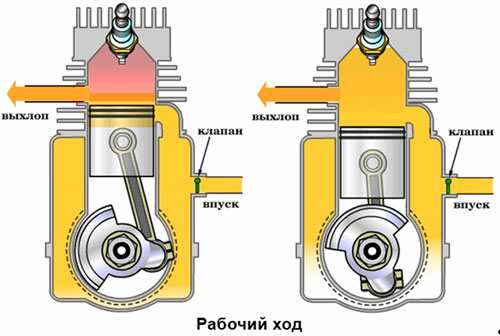
- Lubrication method.
- For four-stroke engines is characterized by a large fuel economy (its consumption is approximately 20 ÷ 30% less), and their exhaust contains less toxic substances
- The method of supplying fuel mixed with atmospheric air into the cylinder and the removal of exhaust gases. In 4-stroke motors for this purpose gas distribution mechanism: when necessary, it opens the valve and closes them. In 2-stroke models, it is missing.
- Operating noise level: 4-way units are quieter.
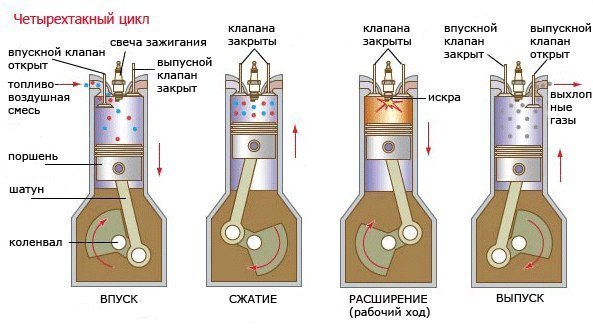
- The complexity of the device: 2-stroke models are simpler.
- The service life of the four-stroke engine models is greater due to the improved lubrication system, and also because the crankshaft rotates at a lower frequency.
- Fast set of maximum speed: 2-stroke units accelerate faster.
- By the simplicity of periodic maintenance and in terms of repair, it is easier to deal with a 2-stroke engine. Also, this engine is cheaper in price and weighs less than a four-stroke equivalent.
Power density is the ratio between the power of the drive unit and its mass. Under the liter capacity understand the relationship between power and engine size (in liters).
The lack of a gas distribution unit with valves makes the two-stroke engines easier and simpler from the point of view of the device. Filling the cylinder with the fuel-air mixture and cleaning it from gas occurs during expansion and contraction through special openings: inlet (purge) and outlet.
Engine Differences in Lubrication Methods
The essential point is the difference in the method of lubrication of two-stroke and four-stroke internal combustion engines: for the first, refueling is required not with pure gasoline, but with its mixture in the required proportion with oil. It, connecting with air, circulates in the piston assembly, lubricating the walls of the cylinder, the crankshaft and connecting rod bearings, as well as the pistons themselves. When the fuel mixture ignites, the oil, the smallest droplets included in its composition, also burns. Combustion products are discharged as exhaust gas. In practice, the two-stroke lawnmower oil is mixed with gasoline in certain proportions.

There are 2-stroke engines with separate flow of these components of the fuel mixture, but this more advanced option is not installed on mowers.
When the motor is 4-stroke, oil is supplied separatelywithout pre-mixing with gasoline. Almost lubrication is realized due to the presence of pipelines, oil pump, valves, filters. The latter is designed to clean the oil from small metal particles formed during wear of parts.
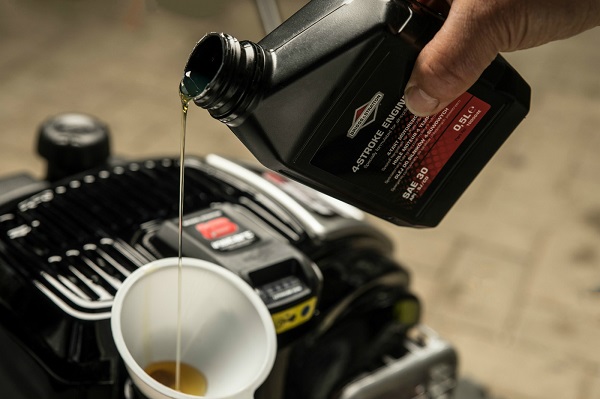
It turns out that in 2-stroke engines the oil burns during operation, and in 4-stroke engines it does not, remaining a long period to circulate in the system. Because of this, the requirements for its performance properties are different. Two-stroke engine oil should leave after burning the minimum possible amount of soot, and for four-stroke units it is necessary that the used lubricant maintains its initial physicochemical parameters for a long time.
Suitable oil and gasoline for refueling 2-stroke engine
Two-stroke gasoline engines are designed to work on the fuel mixture. Changing the oil in the lawn mower is not done separately - it is proportionally mixed with gasoline. In this case, only the correctly prepared fuel composition should be poured into the engine system.
It is impossible to pour oil according to the principle “the higher its price, the better it will be for the mechanism to work”. The types of oil compositions suitable for 2-stroke internal combustion engines are divided into the following groups according to the method of their preparation:
- semi-synthetic;
- synthetic;
- mineral.
The lubricating properties of the material depend on the base,its ability to remain in a liquid state at a decrease in temperature, without significantly increasing the viscosity at the same time. The composition of the lubricant includes approximately 5-15% of various additives. They are intended to increase the practical effectiveness of the tool used. Additives allow you to:
- slow down the course of corrosion of metal surfaces associated with redox reactions;
- increase the thermal resistance of parts;
- stabilize the viscosity index of a substance at the same level as temperature changes in a certain range.
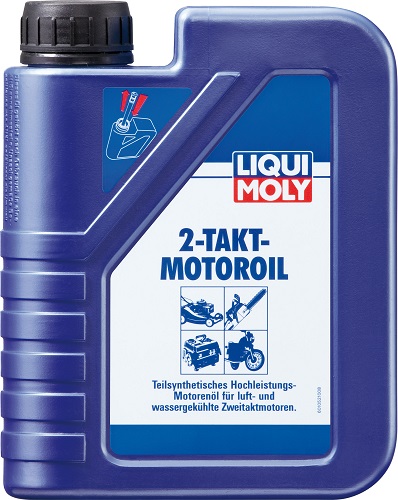
Manufacturers of lawn mowers in the instructions indicate the brand of lubricant, which is the best option for the operated unit. If it is problematic to get it, then it is possible to change the oil for a similar composition intended for 2-stroke internal combustion engines. Wherein viscosity level must necessarily correspond to the value recommended by the manufacturer of the product.
Gasoline is the main bulk component of the prepared fuel mixture. Its brand must comply with the recommended lawnmower in the instruction manual. Of magnitude octane number gasoline depends on the time of its combustion: the higher the number, the longer the fuel burns.
If you use a higher-grade gasoline than recommended, then a two-stroke internal combustion engine will fail faster.
Fuel mixture preparation
To obtain a fuel mixture, engine oil is mixed with gasoline in certain proportions. They are given in the instruction manual. So, mineral lubricants are mixed with gasoline in the ratio of 1 to 35, and synthetic - 1 to 50.
The mixture is prepared as follows:
- the exact amount of gasoline is poured into the canister;
- add, using a dispenser, the required volume of oil;
- close the container with a lid;
- mix the composition by shaking the liquid.

The prepared fuel mixture is simply poured. inside the gas tank, applying for convenience a watering can.
The proportional ratios between oil and gasoline in the composition of the fuel are presented in the table below. It will allow you to quickly determine the volumes of mixed materials.
Store the cooked mixture of gasoline and oil can in polypropylene or metal tanks no more than two weeks. Save the composition in plastic bottles can not.This is due to the fact that gasoline reacts with the material of the container, and the resulting products fall into the working mixture. Because of this, during the combustion of the composition will form more soot.
Filling the fuel mixture is allowed only if the engine is almost completely cooled. A tank to the top cannot be poured in at the same time: leave room for the temperature expansion of the fuel.
It is necessary to follow the rules of fire and personal safety, performing the work of preparing and pouring the working composition away from sources of fire.
Oil change in a 4-stroke engine
In a lawnmower with a four-stroke engine, gasoline is required to be poured into the tank, and the oil in a special hole that is in the crankcase. The operating manual for the equipment from the manufacturer contains information on the frequency of lubricant replacement.
It should be taken into account that the efficiency of the lubricant after about 50 hours of operation of the unit decreases. If it is necessary to mow small areas, then in one season, so many working hours are unlikely to accumulate. In this case, the lubricant should be changed when the apparatus is preserved for the autumn-winter period of time.

Change engine oil as follows:
- approximately for 15 minutes, the mower motor is started at idle speed so that the system warms up, and due to this, the fluidity of the lubricant increases (the viscosity decreases);
- unscrew the drain plug located on the crankcase;
- tilt the lawn mower in the direction of the drain, pre-substituting capacity to collect the used lubricant (as in the photo below);
- after working off will flow, the cork is twisted into place;
- mower mounted on a flat area;
- open the upper hole;
- fill in a new oil suitable for a 4-stroke engine, periodically checking its level with a dipstick;
- when the lubricant reaches the required mark, the filling hole is closed, tightly twisting the plug.
The volume of the poured material is usually 500-600 ml.
For pouring into four-stroke internal combustion engines, you can use various oils that are suitable for their performance properties, for example, 10W40, SAE-30. For most models fit lubricant composition class SF and above. It is recommended to pour frost-resistant grease for the winter.
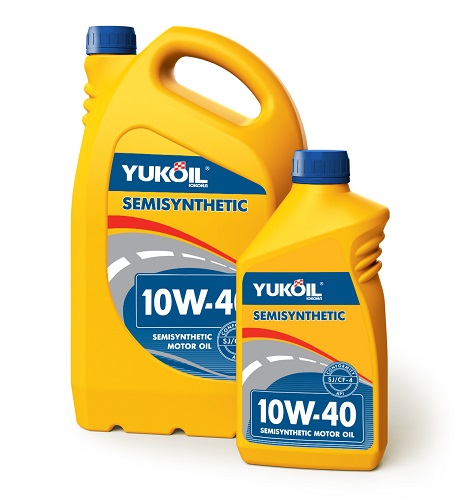
YUKO SEMISYNTHETIC 10W-40 semi-synthetic oil
It is not recommended to drain testing directly onto the soil in order not to contaminate it. To select a used lubricant, you can also use a variety of devices. One of the possible options is presented in the photo below.
The process of replacing the lubricant in the motor of the wheel mower is quite simple. All operations usually take up to 30 minutes to complete.
It should be remembered that the oil and gasoline for a lawn mower with a four-stroke engine are not mixed, but poured separately.
The best option for both two-stroke and four-stroke engines is the use of gasoline and oil, recommended by manufacturers. Instructions on suitable marks are given in the operating instructions for the mower. The lubricant must have a viscosity not lower than the specified one, otherwise it will simply not be able to properly perform its functions. Gasoline used should not be branded higher than that recommended by the manufacturer, because pistons, valve or rings can burn out. When filling in with fuel or lubricant, it is also necessary to observe their volumes, given in the instructions.Especially the proportions should be observed when preparing the oil-gasoline mixture.

/rating_on.png)
/rating_off.png)








